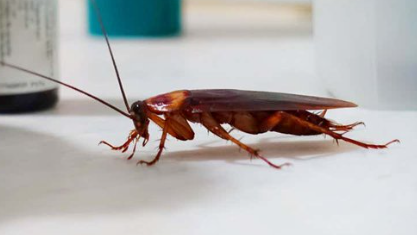Recent research indicates that many insecticides, particularly those containing pyrethroids, are becoming increasingly ineffective against cockroaches. Studies have shown that German cockroaches, a common pest in urban areas, have developed significant resistance to these chemicals. In fact, field-collected cockroach populations have demonstrated such high levels of resistance that they are rarely affected by pyrethroid-based insecticides, which are commonly found in consumer-grade products like sprays and aerosols.
A recent study published in the Journal of Economic Entomology has revealed that commercial insecticides, particularly those containing pyrethroids, are largely ineffective in controlling cockroach populations. The research specifically focused on German cockroaches, one of the most pervasive pest species worldwide, and found that these insecticides “add little to no value to cockroach control.”
The study’s findings highlight that pyrethroids, a common component in household insecticides, fail to effectively eliminate German cockroaches. Pyrethroids are synthetic chemicals modeled after compounds found in certain flowers, and while they are generally tested on a variety of insects, their efficacy against cockroaches is not guaranteed. Dr. Johnalyn Gordon, a postdoctoral researcher at the University of Florida, explained, “Due to the frequent use of pyrethroid-based residual products, it is very likely that German cockroaches inside homes will have some degree of pyrethroid resistance.”
Consumer insecticides are useless for fighting cockroach infestations https://t.co/6HHCygfZsj
— New Scientist (@newscientist) August 24, 2024
The study examined cockroaches from various U.S. locations, comparing their resistance to pyrethroids with that of a lab-bred population known as Orlando Normal, which has been isolated from insecticides for over 70 years. While the Orlando Normal cockroaches were highly susceptible to pyrethroids, the field cockroaches showed significant resistance. Fewer than 20% of these cockroaches died after exposure to surfaces treated with the insecticide, indicating a high level of resistance among the pests.
This resistance poses a substantial challenge to pest control efforts, as direct spraying of cockroaches often does not reach every individual, allowing some to survive and continue infesting homes. The researchers also found that the effectiveness of pyrethroids varied depending on the type of surface. For example, drywall, a common household material, was less effective in killing cockroaches than ceramic or stainless steel surfaces. Even the vulnerable Orlando Normal cockroaches mostly survived after exposure to treated drywall, suggesting that the porosity of a surface significantly impacts the effectiveness of insecticides.
Given these findings, the study suggests that alternative methods, such as gels or baits, might be more effective for controlling cockroach populations. These methods are often employed by professional pest control services, which utilize a combination of strategies to eradicate infestations. However, such services can be costly and are not always accessible to everyone.
I found this on NewsBreak: California school district under fire for spending $315K on New Age energy healer while teachers forced to clean up cockroach infestations https://t.co/Q56bvHR5U1
— Della Crabtree (@DellaCrabt59494) August 23, 2024
Dr. Gordon emphasized the need for more effective solutions, particularly in areas where cockroach infestations are most prevalent and residents lack access to professional pest control services. “There is a strong base of knowledge and research on how we can control cockroaches, but there are numerous economic and procedural barriers that mean that this control is not occurring in these areas, arguably where it is the most needed,” she stated. Without effective solutions, residents remain vulnerable to the health risks associated with cockroach allergens and infestations.
The study’s findings underscore the importance of developing more effective and accessible pest control strategies to address the growing issue of cockroach resistance to common insecticides.
More Information
One study highlighted that less than 20% of cockroaches exposed to surfaces treated with these insecticides died within a 30-minute window, even when confined to those surfaces. The study also found that the efficacy of these insecticides significantly diminishes on certain surfaces, such as painted drywall, compared to ceramic tiles or stainless steel. This suggests that the type of surface plays a crucial role in how well these products work. Moreover, cockroaches tend to avoid resting on treated surfaces, further reducing the effectiveness of these insecticides.
Experts suggest that alternatives, such as gel or liquid baits containing slow-acting insecticides, may be more effective for controlling cockroach populations. These products lure cockroaches to a food source that contains poison, rather than relying on contact with treated surfaces. Integrated pest management (IPM), which combines different control methods, is also recommended as a more comprehensive approach to pest control, particularly in low-income and multi-family housing where infestations are persistent.
There is a call for more stringent testing and evaluation of insecticide products to ensure they are effective against resistant cockroach populations. Current regulations do not require products to be tested on field-collected cockroaches or those that have demonstrated resistance, which means many products on the market may not provide the level of control they advertise.
Key Points:
i. A study published in the Journal of Economic Entomology found that commercial insecticides containing pyrethroids are largely ineffective against German cockroach infestations.
ii. Pyrethroids, commonly used in household insecticides, fail to kill most German cockroaches due to developed resistance, especially when applied to certain surfaces like drywall.
iii. The study compared wild cockroach populations with a lab-bred strain and found significantly higher resistance in the field populations, with fewer than 20% dying after exposure.
iv. Researchers suggest that alternative methods, such as gels or baits, may be more effective for cockroach control, though professional pest control services using these methods can be expensive.
v. Dr. Johnalyn Gordon emphasized the need for more accessible pest control solutions to mitigate health risks and address infestations effectively in areas where professional services are not available.
Kirk Volo – Reprinted with permission of Whatfinger News

